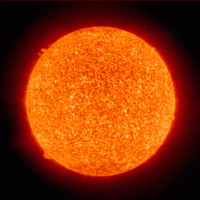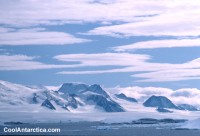
|
Jan 23, 2008
Scientist Says Earth May Soon Face New Ice Age
RIAN News Service
Temperatures on Earth have stabilized in the past decade, and the planet should brace itself for a new Ice Age rather than global warming, a Russian scientist said in an interview with RIA Novosti Tuesday. “Russian and foreign research data confirm that global temperatures in 2007 were practically similar to those in 2006, and, in general, identical to 1998-2006 temperatures, which, basically, means that the Earth passed the peak of global warming in 1998-2005,” said Khabibullo Abdusamatov, head of a space research lab at the Pulkovo observatory in St. Petersburg.
According to the scientist, the concentration of carbon dioxide in the Earth’s atmosphere has risen more than 4% in the past decade, but global warming has practically stopped. It confirms the theory of “solar” impact on changes in the Earth’s climate, because the amount of solar energy reaching the planet has drastically decreased during the same period, the scientist said. Had global temperatures directly responded to concentrations of “greenhouse” gases in the atmosphere, they would have risen by at least 0.1 Celsius in the past ten years, however, it never happened, he said.
“By the mid-21st century the planet will face another Little Ice Age, similar to the Maunder Minimum, because the amount of solar radiation hitting the Earth has been constantly decreasing since the 1990s and will reach its minimum approximately in 2041,” he said. Mankind will face serious economic, social, and demographic consequences of the coming Ice Age because it will directly affect more than 80% of the earth’s population, the scientist concluded. Read more here.

Today’s solar image from NASA showing a spotless sun approaching 12 years after the last solar minimum. The last cycle lasted 9.5 years. Longer cycles usually correlate with cooling. A good site to follow the daily solar activity is here.
Jan 23, 2008
Scientists: Warm Seas May Mean Fewer Hurricanes
By Ken Kaye, Sun Sentinel
Following in the footsteps of an earlier study, government scientists on Tuesday said warmer oceans should translate to fewer Atlantic hurricanes striking the United States. The reason: As sea surface temperatures warm globally, sustained vertical wind shear increases. Wind shear makes it difficult for storms to form and grow. “Using data extending back to the middle 19th century, we found a gentle decrease in the trend of U.S. landfalling hurricanes when the global ocean is warmed up,” Chunzai Wang, a physical oceanographer and climate scientist with NOAA’s Atlantic Oceanographic and Meteorological Laboratory in Miami, said in a prepared statement. Sang-Ki Lee, of the Cooperative Institute for Marine and Atmospheric Studies at the University of Miami, worked with Wang on the study. Their findings are to be published on Wednesday in the journal Geophysical Research Letters. The study found that the warming of the Pacific and Indian oceans plays an important role in determining hurricane activity in the Atlantic.
A study released in December found that as the Atlantic basin becomes hotter, hurricane intensity likely won’t increase and might even deflate somewhat. That study found that ocean’s heat acts to stabilize the upper atmosphere, which, in turn, hurts a storm’s ability to build. It was conducted by Gabriel Vecchi, a NOAA research oceanographer and Brian Soden, an associate professor of oceanography at the University of Miami. Read more here.

Jan 22, 2008
Antarctica Snowfall Increase
World Climate Report
The ice caps hold a special place in the cold hearts of the global warming advocates who are all too quick to insist that our ice caps are currently melting at an unprecedented rate. We suspect that they will not be particularly thrilled to learn that a paper has just appeared in Geophysical Research Letters entitled “A doubling in snow accumulation in the western Antarctic Peninsula since 1850.” The article is by scientists with the British Antarctic Survey and the Desert Research Institute in Reno, Nevada; the work was funded by the UK Natural Environment Research Council and the U.S. National Science Foundation. In case you think that the Desert Research Institute in Nevada would have little interest in Antarctica, recall from geography classes you’ve had that Antarctica receives little precipitation and is regarded by climatologists as a frozen desert.
So while we’ve heard recent reports about Antarctica losing ice, here we again find evidence to the contrary, and then some, at least in these locations. Not only is there no evidence of melting at the Gomez site, snow is accumulating there at an amazingly high rate. Clearly, this paper adds to the evidence that suggests that we simply, as of yet, do not have a firm grasp on the climate changes and their drivers that are effecting Antarctica, past, present, or, much less, future.
Read more here.

The Antarctic Peninsula. Full size image here.
Jan 17, 2008
Gore Scientific “Adviser” Says That He Has No “Responsibility” for An Inconvenient Truth Errors
By Steve McIntyre, Climate Audit
In earlier posts, we observed that Al Gore’s An Inconvenient Truth claimed that “Dr Thompson’s thermometer” confirmed Michael Mann’s hockey stick, but, when analysed, what Gore described as “Dr Thompson’s thermometer” merely proved to be Michael Mann’s hockey stick mis-identified. No wonder it resembled Mann’s hockey stick - or, to use the phrase more common in climate science, no wonder there was a “remarkable” resemblance.
Hu McCulloch of Ohio State University now writes about a recent encounter with Lonnie Thompson, the serial ice core non-archiver: On January 11, Lonnie Thompson gave a talk on Climate change at Ohio State. After his talk, I asked him if the graph identified by Al Gore as “Dr. Thompson’s Thermometer” in his book and film was really based on his ice core research.
Thompson admitted that an error had been made, and even had a slide ready that showed the data of the Mann Hockey Stick plus Jones instrumental data that Gore’s figure was based on, alongside an average of dO18 z-scores from 6 of his Andean and Himalayan ice cores, similar to the 7-series graph that appeared in his 2006 PNAS article. He stated that he recognized the error right away, and even sent Gore (and Mann, as I recall) an e-mail pointing out the mistake.
When I pressed him if it wouldn’t be appropriate to make a more public announcement, given the high-profile nature of the error, Ellen Mosley-Thompson, his wife and co-author, stood up and offered that it was Gore’s error, not theirs, so that they had no responsibility for it, and that in any event there was no forum in which to make a correction. Thompson’s online CV says that he was on the “Science Advisory Board” for Inconvenient Truth prior to its release in April 2006. So he was on the Board but he didn’t bear any responsibility. Sure, Lonnie. Sure, Ellen.
Gore used the term “my friend Lonnie Thompson” and Thompson doesn’t know how to correct the error. Sure, Lonnie. “No responsibility.” “No forum”. No shame.
Read full blog and comments here.
Jan 17, 2008
What Can We Learn about Global Warming from Poor Reporting?
William M. Briggs, Climate Statistician
From today’s Syndney Morning Herald comes the headline: “Global warming to impact health”. First, by impact the reporter almost certainly means influence, a more accurate, but far less energetic and “actionable”, word. But never mind that. Our lesson instead comes from the story, one of a breed which appears almost daily in some major newspaper somewhere in the world. But before we can get to it, you first have to learn, if you do not already know it, the definition of tautology. A tautology is a statement which is always true; that is, no matter what happens in the word, no matter what conditions eventually hold, a tautology will be true. Some examples: “Either it will rain tomorrow or it won’t” and “Marxism is a stupid theory or it is not.”
Here, from the article we are studying, is the lead sentence; it is a tautological fragment, “Rises in temperature produced by global warming could result in an increase in the number of people being admitted to hospital with kidney disease, heart disease and mental illness in Australian cities.” To make this into a grammatically correct tautology we need only add the implied clause “or the rise in temperature will not result in an increase, etc., etc.” So the reporter has written something which is true, which will always be true, and will be true regardless whether mankind influences the climate or not. But he has written his tautology in such a way to show where his sympathies lie, much as I did in my second example. In any case, we have no grounds for criticizing the reporter on the grounds of accuracy. All such attempts, which I have seen from the skeptical community, are doomed to failure.
We now have to look at the “study” on which the reporter did his article. This will require some work from us, but it is exceedingly important that you understand this study, because it is entirely typical of academic work in this area. You will see more of its kind, and with increasing frequency, so it is imperative that you learn to recognize it and ascertain how to properly criticize it. Read more here.
Dr. William M. Briggs specializes in the statistics of forecast evaluation, serves on the American Meteorological Society’s Probability and Statistics Committee and is an Associate Editor of Monthly Weather Review.
|
|
|
|





